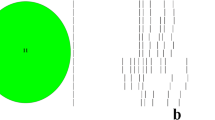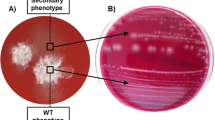Abstract
Clostridioides (C.) difficile are found in cows, pigs and poultry suggesting that this pathogen is present and more importantly animals could act as a reservoir, via food or environment, of human C. difficile infection. Molecular methods together with phenotypical characterisation bring integrated and important tools to describe diversity and nature of bacteria including C. difficile. Moreover, similar or identical C. difficile types are found in different farm animals. This study aimed to phenotypically characterise C. difficile isolates belonging to ribotype 078 and to identify differences such as growth and toxicity between porcine and bovine isolates. C. difficile isolates were assessed for the growth behaviour (turbidimetry), metabolic potential (Biolog AN) and toxin production (ELISA method) in vitro. The concentration of released either toxin A (TcdA) or toxin B (TcdB) varied greatly between the isolates tested; however, it did not differ between the porcine and bovine ribotypes. Also, the TcdA/TcdB ratio of the isolates did not show a difference either. The most common metabolised substrates were pyruvic acid followed by α-ketobutyric acid. The results show that both porcine and bovine C. difficile RT 078 share similar phenotypical characteristics including growth and production of toxins. The findings may help understand the virulence of C. difficile RT 078 in porcine and bovine species.

Similar content being viewed by others
References
Bauer MP, Notermans DW, Van Benthem BH, Brazier JS, Wilcox MH, Rupnik M, Monnet DL, Van Dissel JT, Kuijper EJ (2011) Clostridium difficile infection in Europe: a hospital-based survey. Lancet 377:63–73
Carman RJ, Stevens AL, Lyerly MW, Hiltonsmith MF, Stiles BG, Wilkins TD (2011) Clostridium difficile binary toxin (CDT) and diarrhea. Anaerobe 17:161–165
Clements AC, Magalhães RJS, Tatem AJ, Paterson DL, Riley TV (2010) Clostridium difficile PCR ribotype 027: assessing the risks of further worldwide spread. Lancet Infect Dis 10:395–404
Collins DA, Elliott B, Riley TV (2015) Molecular methods for detecting and typing of Clostridium difficile. Pathology 47:211–218
Debast SB, van Leengoed LAMG, Goorhuis A, Harmanus C, Kuijper EJ, Bergwerff AA (2009) Clostridium difficile PCR ribotype 078 toxinotype V found in diarrhoeal pigs identical to isolates from affected humans. Environ Microbiol 11:505–511
Fawley WN, Knetsch CW, MacCannell DR, Harmanus C, Du T, Mulvey MR, Paulick A, Anderson L, Kuijper EJ, Wilcox MH (2015) Development and validation of an internationally-standardized, high-resolution capillary gel-based electrophoresis PCR-Ribotyping protocol for Clostridium difficile. PLoS One 10:e0118150
George WL, Sutter VL, Finegold SM (2000) Toxigenicity and antimicrobial susceptibility of Clostridium difficile, a cause of antimicrobial agent-associated colitis 99:55–58
Gerding DN, Johnson S, Rupnik M, Aktories K (2013) Clostridium difficile binary toxin CDT: mechanism, epidemiology, and potential clinical importance. Gut Microbes 5:15–27
Goorhuis A, Bakker D, Corver J, Debast SB, Harmanus C, Notermans DW, Bergwerff AA, Dekker FW, Kuijper EJ (2008) Emergence of Clostridium difficile infection due to a new hypervirulent strain, polymerase chain reaction ribotype 078. Clin Infect Dis 47:1162–1170
Grześkowiak Ł, Zentek J, Vahjen W (2016a) Physical pre-treatment improves efficient DNA extraction and qPCR sensitivity from Clostridium difficile spores in faecal swine specimens. Curr Microbiol 73:727–731
Grześkowiak Ł, Zentek J, Vahjen W (2016b) Determination of the extent of Clostridium difficile colonisation and toxin accumulation in sows and neonatal piglets. Anaerobe 40:5–9
Grzeskowiak L, Martinez-Vallespin B, Dadi TH, Radloff J, Amasheh S, Heinsen F-A, Franke A, Reinert K, Vahjen W, Zentek J, Pieper R (2017) Formula-feeding predisposes neonatal piglets to Clostridium difficile gut infection. J Infect Dis 217:1442–1452. https://doi.org/10.1093/infdis/jix567
Gunsalus IC, Horecker BL, Wood WA (1955) Pathways of carbohydrate metabolism in microorganisms. Bacteriol Rev 19:79–128
History A (2015) Fatal case of Clostridium difficile infection in a neonatal piglet in Korea. Pak Vet J 8318:85–92
Indra A, Lassnig H, Baliko N, Much P, Fiedler A, Huhulescu S, Allerberger F (2009) Clostridium difficile: a new zoonotic agent? Wien Klin Wochenschr 121:91–95
Jenior ML, Leslie JL, Young VB, Schloss PD (2017) Clostridium difficile colonizes alternative nutrient niches during infection across distinct murine gut microbiomes. mSystems 2:e00063–e00017
Karlsson S, Lindberg A, Norin E, Burman LG, Akerlund T (2000) Toxins, butyric acid, and other short-chain fatty acids are coordinately expressed and down-regulated by cysteine in Clostridium difficile. Infect Immun 68:5881–5888
Keel MK, Songer JG (2007) The distribution and density of Clostridium difficile toxin receptors on the intestinal mucosa of neonatal pigs. Vet Pathol 44:814–822
Keel K, Brazier JS, Post KW, Weese S, Songer JG (2007) Prevalence of PCR ribotypes among Clostridium difficile isolates from pigs, calves, and other species. J Clin Microbiol 45:1963–1964
Keessen EC, Hensgens MP, Spigaglia P, Barbanti F, Sanders IM, Kuijper EJ, Lipman LJ (2013) Antimicrobial susceptibility profiles of human and piglet Clostridium difficile PCR-ribotype 078. Antimicrob Resist Infect Control 2:14
Klose V, Bayer K, Bruckbeck R, Schatzmayr G, Loibner A-P (2010) In vitro antagonistic activities of animal intestinal strains against swine-associated pathogens. Vet Microbiol 144:515–521
Knetsch CW, Hensgens MPM, Harmanus C, van der Bijl MW, Savelkoul PHM, Kuijper EJ, Corver J, van Leeuwen HC (2011) Genetic markers for Clostridium difficile lineages linked to hypervirulence. Microbiology 157:3113–3123
Knetsch CW, Connor TR, Mutreja A, van Dorp SM, Sanders IM, Browne HP, Harris D, Lipman L, Keessen EC, Corver J, Kuijper EJ, Lawley TD (2014) Whole genome sequencing reveals potential spread of Clostridium difficile between humans and farm animals in the Netherlands, 2002 to 2011. Eurosurveillance [Online] 19:20954
Lawson PA, Citron DM, Tyrrell KL, Finegold SM (2016) Reclassification of Clostridium difficile as Clostridioides difficile (Hall and O’Toole 1935) Prévot 1938. Anaerobe 40:95–99
Merrigan M, Venugopal A, Mallozzi M, Roxas B, Viswanathan VK, Johnson S, Gerding DN, Vedantam G (2010) Human hypervirulent Clostridium difficile strains exhibit increased sporulation as well as robust toxin production. J Bacteriol 192:4904–4911
Moono P, Putsathit P, Knight DR, Squire MM, Hampson DJ, Foster NF, Riley TV (2015) Persistence of Clostridium difficile RT 237 infection in a Western Australian piggery. Anaerobe 37:62–66
Nakamura S, Nakashio S, Yamakawa K, Tanabe N, Nishida S (1982) Carbohydrate fermentation by Clostridium difficile. Microbiol Immunol 26:107–111
Norén T, Johansson K, Unemo M (2014) Clostridium difficile PCR ribotype 046 is common among neonatal pigs and humans in Sweden. Clin Microbiol Infect 20:O2–O6. https://doi.org/10.1111/1469-0691.12296
Rodriguez C, Taminiau B, Van Broeck J, Avesani V, Delmée M, Daube G (2012) Clostridium difficile in young farm animals and slaughter animals in Belgium. Anaerobe 18:621–625
Rodriguez C, Avesani V, Van Broeck J, Taminiau B, Delmée M, Daube G (2013) Presence of Clostridium difficile in pigs and cattle intestinal contents and carcass contamination at the slaughterhouse in Belgium. Int J Food Microbiol 166:256–262. https://doi.org/10.1016/j.ijfoodmicro.2013.07.017
Rodriguez-Palacios A, Borgmann S, Kline TR, LeJeune JT (2013) Clostridium difficile in foods and animals: history and measures to reduce exposure. Anim Health Res Rev 14:11–29
Russello G, Russo A, Sisto F, Scaltrito MM, Farina C (2012) Laboratory diagnosis of Clostridium difficile associated diarrhoea and molecular characterization of clinical isolates. New Microbiol 35:307–316
Schneeberg A, Neubauer H, Schmoock G, Baier S, Harlizius J, Nienhoff H, Brase K, Zimmermann S, Seyboldt C (2013a) Clostridium difficile genotypes in piglet populations in Germany. J Clin Microbiol 51:3796–3803
Schneeberg A, Neubauer H, Schmoock G, Grossmann E, Seyboldt C (2013b) Presence of Clostridium difficile PCR ribotype clusters related to 033, 078 and 045 in diarrhoeic calves in Germany. J Med Microbiol 62:1190–1198
Songer JG (2004) The emergence of Clostridium difficile as a pathogen of food animals. Anim Health Res Rev 5:321–326
Songer JG, Anderson MA (2006) Clostridium difficile: an important pathogen of food animals. Anaerobe 12:1–4
Spigaglia P, Drigo I, Barbanti F, Mastrantonio P, Bano L, Bacchin C, Puiatti C, Tonon E, Berto G, Agnoletti F (2015) Antibiotic resistance patterns and PCR-ribotyping of Clostridium difficile strains isolated from swine and dogs in Italy. Anaerobe 31:42–46
Stabler RA, He M, Dawson L, Martin M, Valiente E, Corton C, Lawley TD, Sebaihia M, Quail MA, Rose G, Gerding DN, Gibert M, Popoff MR, Parkhill J, Dougan G, Wren BW (2009) Comparative genome and phenotypic analysis of Clostridium difficile 027 strains provides insight into the evolution of a hypervirulent bacterium. Genome Biol 10:1–15
Stefanowicz A (2006) The biolog plates technique as a tool in ecological studies of microbial communities. Polish J Environ Stud 15:669–676
Underwood S, Guan S, Vijayasubhash V, Baines SD, Graham L, Lewis RJ, Wilcox MH, Stephenson K (2009) Characterization of the sporulation initiation pathway of Clostridium difficile and its role in toxin production. J Bacteriol 191:7296–7305
Voth D, Ballard J (2005) Clostridium difficile toxins: mechanism of action and role in disease. Clin Microbiol Rev 18:247–263. https://doi.org/10.1128/CMR.18.2.247
Waters EH, Orr JP, Clark EG, Schaufele CM (1998) Typhlocolitis caused by Clostridium difficile in suckling piglets. J Vet Diagnostic Investig 10:104–108
Acknowledgments
This study is part of the SporeBiotic research project financially supported by the Animal Health and Welfare ERA-Net (ANIHWA).
Author information
Authors and Affiliations
Corresponding author
Ethics declarations
Conflict of interest
The authors declare that they have no conflict of interest.
Electronic supplementary material
Supplemental figure 1
A dendrogram and a heat map associating each isolate with the catabolised metabolites. (PNG 1374 kb)
Rights and permissions
About this article
Cite this article
Grześkowiak, Ł., Riedmüller, J., de Thomasson, H. et al. Porcine and bovine Clostridium difficile ribotype 078 isolates demonstrate similar growth and toxigenic properties. Int Microbiol 21, 215–221 (2018). https://doi.org/10.1007/s10123-018-0018-x
Received:
Revised:
Accepted:
Published:
Issue Date:
DOI: https://doi.org/10.1007/s10123-018-0018-x




